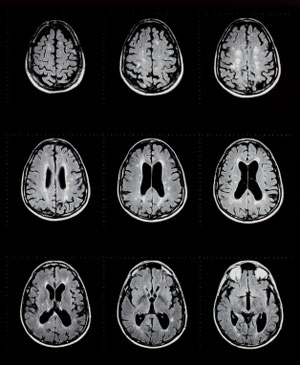"Rebooting" MS Drug Succeeds In Trials
Friday 2 November 2012 - 3am PST
Featured ArticleAcademic Journal
Two phase 3 trials of a drug for treating multiple sclerosis (MS)
that "reboots" the immune system showed it to be effective in patients
who had not
responded to first-line therapy: it reduced risk of disability and brain
shrinkage.
Reporting in the 1 November issue of The Lancet,
the researchers describe how
alemtuzumab (known commercially as Lemtrada), previously used to treat a
type of leukaemia, was able to help people with early MS who relapsed
on previous
treatments as well as patients who had not yet received any treatment.
Alastair Compston, a professor from the University of Cambridge was
principal investigator on both trials and also chaired the Steering
Committee that
supervised them and an earlier trial. He said in a statement from the
University:
"Our research shows the transformative effect that alemtuzumab can have for people with MS."
The findings mark the conclusion of a unique development program for an
MS drug that started in Cambridge in 1991.
The statement from the
University
says:
"Never before has an MS drug been tested in clinical outcomes against
such a high hurdle, an active first-line drug, in both one phase II
trial and two phase III
trials; and
no drug for MS has been shown to be more effective, in both
reducing the risk of disability and reducing the rate of brain atrophy,
when compared to
another active treatment."
MS is an autoimmune disease where the patient's immune system destroys
nerve fibers and their protective insulation, the myelin sheath. The
resulting damage
stops nerves communicating with each other, leading eventually to loss
of the nerve fiber, and progressive physical and cognitive disability.
The disease affects millions of people worldwide, including almost 100,000 in the UK, and 400,000 in the US.
The two randomized, controlled phase 3 trials, reported in two separate
papers, are called CARE MS I and CARE MS II. They were both funded by
Genzyme
(Sanofi) and Bayer Schering Pharma.
The developers expect decisions on drug licences for alemtuzumab by the
European and US regulatory authorities to be made in 2013.
In another study reported this week, scientists describe how it may be possible to repair the
nerve fiber damage caused by MS.
CARE MS I: Alemtuzumab Versus Interferon beta-1a as First Treatment in RRMS Patients
This three-year trial involved 334 patients with active, early relapsing
remitting MS (RRMS) who had not received any treatment for the disease
(drug-naïve
patients). It tested the
performance of alemtuzumab against the
first-line drug interferon beta-1a (commercially known as Rebif).
The patients were randomly assigned to one of three groups. One group
received interferon beta-1a injections three times a week, and the other
two groups
each received a different daily intravenous dose of alemtuzumab.
The results showed that alemtuzumab reduced the number of attacks by 55% over and above that achieved by the other first-line drug.
Over a 2-year period, 78% of the patients taking alemtuzumab remained relapse free, compared with 59% in the interferon group.
The percentage of patients whose disability got worse during the trial
was slightly lower in the alemtuzumab patients than in the interferon
patients, but the
result was not statistically significant.
The researchers conclude:
"Alemtuzumab reduced disease activity compared with interferon beta-1a
in most of the analysed subgroups. Significantly greater numbers of
patients
experienced sustained improvement in disability after treatment with
alemtuzumab than interferon beta-1a.
The efficacy offered by alemtuzumab is a
substantial advance in the treatment of multiple sclerosis."
CARE MS II: Alemtuzumab After Failed First-Line Treatment in RRMS Patients
For this 2-year trial, researchers recruited 840 patients agd 18 to 55
with RRMS (from which data from 628 participants was used in the
principal analysis), who
had received first-line treatment but had recently relapsed during their
therapy.
As with the MS I trial, the participants were randomly assigned to
received either alemtuzumab or interferon beta-1a. Each patient had
their disability assessed
every three months by a researcher who did not know which drug they were
receiving. They also underwent annual scans to assess lesions and
brain shrinkage
due to MS.
The results showed that
new relapses were reduced by 49% more in the alemtuzumab than the interferon patients.
Over the 2-year period, 65% of patients on alemtuzumab remained relapse free compared with 47% of interferon patients.
Alemtuzumab reduced the risk of acquiring disability by 42% compared to
interferon: disability worsened in 20% of interferon patients and 13% of
alemtuzumab
patients.
Plus, at the end of the study, on average, the patients taking
alemtuzumab had less disability than when they started the trial whereas
the patients taking
interferon had more disability.
The brain scans showed that alemtuzumab not only reduced the number of new lesions, compared to interferon beta-1a, but also
reduced the rate of brain
shrinkage from the tissue damage caused by MS.
The researchers conclude:
"For patients with first-line treatment-refractory relapsing-remitting
multiple sclerosis,
alemtuzumab could be used to reduce relapse rates and sustained
accumulation of disability. Suitable risk management strategies allow
for early identification of alemtuzumab's main adverse effect of
secondary autoimmunity."
Implications
Compston says:
"Patients who continue to show disease activity while on their initial
therapy are especially difficult to treat. Now, we have shown that
alemtuzumab works where
first-line drugs have already failed."
The drug "not only reduces the chances of disability associated with
MS", but it "may even result in long-term clinical improvements," he
adds.
In both trials the main side effect from alemtuzumab was the development of other autoimmune diseases.
Additional work by some of the Cambridge researchers on these trials is
looking into how to identify people who are susceptible to this side
effect, and they are
currently recruiting for a trial that is testing alemtuzumab with a new
drug aimed at reducing the adverse reaction.
Written by Catharine Paddock PhD
Copyright: Medical News Today
"Alemtuzumab versus interferon beta 1a as first-line treatment for
patients with relapsing-remitting multiple sclerosis: a randomised
controlled phase 3
trial"; Jeffrey A Cohen, Alasdair J Coles, Douglas L Arnold,
Christian Confavreux, Edward J Fox, Hans-Peter Hartung, Eva Havrdova,
Krzysztof W
Selmaj, and others, for the CARE-MS I investigators;
The Lancet, published online 1 November 2012; DOI: 10.1016/S0140-6736(12)61769-3;
Lin
k to Abstract
"Alemtuzumab for patients with relapsing multiple sclerosis after
disease-modifying therapy: a randomised controlled phase 3 trial";
Alasdair J
Coles, Cary L Twyman, Douglas L Arnold, Jeffrey A Cohen, Christian
Confavreux, Edward J Fox, Hans-Peter Hartung, Eva Havrdova, Krzysztof W
Selmaj, and
others, for the CARE-MS II investigators;
The Lancet, published o
Source:
http://www.medicalnewstoday.com/articles/252315.php









